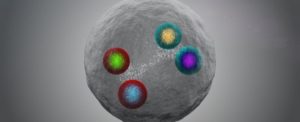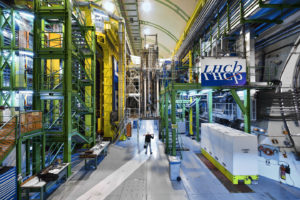FRIDAY, 17 JULY 2020
In a recent manuscript published on the arXiv preprint server, scientists at the Large Hadron Collider beauty (LHCb) experiment at CERN have reported the discovery of a new tetraquark, a rare subatomic particle that could help physicists better understand the strong nuclear force, one of the fundamental forces that govern our universe.Quarks are elementary particles of matter and come in six different types or ‘flavours’: up, down, strange, charm, bottom and top, each with a corresponding ‘antiquark’ antiparticle. They combine in groups of two or more to form hadrons, bound by the strong nuclear force. The most common hadrons in the universe are made up of two or three quarks; for example, the protons and neutrons in atomic nuclei that make up all visible matter, are made up of three quarks each.
 Artist’s impression of a tetraquark, image credit: CERN
Artist’s impression of a tetraquark, image credit: CERN LHCb detector, image credit: M. Brice, J. Ordan, CERN
LHCb detector, image credit: M. Brice, J. Ordan, CERN“These exotic heavy particles provide extreme and yet theoretically fairly simple cases with which to test models that can then be used to explain the nature of ordinary matter particles, like protons or neutrons,” explains incoming spokesperson for the LHCb, Chris Parkes. “It is therefore very exciting to see them appear in collisions at the LHC for the first time.”
The experimental evidence for the new tetraquark was gathered at the LHC over two operational runs, consisting of eight years of particle collision experiments. Proton beams are sped up to extremely high energies in the particle accelerator and collided together to release a plethora of new particles. This allows scientists to study particles that can only be produced under these extreme conditions and test the fundamental physics that governs our universe. However, it means that experiments amass immense quantities of data to be studied and analysed, which requires the development of thorough theoretical models and complex data processing methods. In fact, the LHCb collaboration consists of over 800 scientists and engineers, who work together to reveal the physics hidden in the data.
Often, these rare particles exist for less than a zeptosecond, quickly decaying into more stable products. By retracing the trajectories of the products of these collisions using computational techniques, researchers can piece together which particles came from the same decay processes, working backwards to identify what particles could have originally been formed in the collision.
To identify potential new particles, researchers search for an “excess” in collision events, which will correspond to unexpected peaks in the mass spectrum of detected particles. In this particular discovery, they detected muon particles that were initially thought to originate from the decay of J/ψ mesons, which each consist of a charm and anti-charm quark pair. However, they observed an excess in the mass spectrum of these J/ψ mesons, and the data matched the predictions for the mass of a fully charmed particle (made up of two charm and two anti-charm quarks). The exact internal structure and properties of the new tetraquark are still unknown, but the confirmation of its existence is already an exciting development that could help physicists gain a deeper understanding of the fundamental forces of our universe.
Simone Eizagirre is a graduate student at the EPSRC Doctoral Training Centre in Nanoscience and Nanotechnology.
